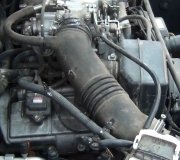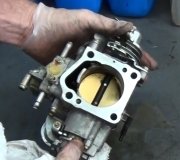First be sure that's the problem. Don't go introducing any more variables that will confuse the Engine Computer. Can you get the text description of the fault code? We don't have a listing for anything under P100 for any car.
A temperature sensor is going to have two wires. If you can carefully back-probe through the rubber seal in the connector, measure the voltages on both wires with the ignition switch on, engine off. Don't pierce the insulation to take those readings. That will let moisture in and corrosion will eat the wires away.
You should find very close to 0.2 volts on the ground wire and somewhere between 0.5 and 4.5 volts on the signal wire. If you find 0.0 volts on both of them, the signal wire is open, (has a break in it). If you do find between typically 2 - 4 volts, the sensor is working properly electrically. The higher the temperature, the lower the voltage will be. If you find 5.0 volts, there's an open circuit in the sensor, the connector pins, or the ground wire. If you also find 5.0 volts on the ground wire, it is open. If you find 5.0 volts on the signal wire and 0.0 volts on the ground wire, there's an open circuit between the two. Temperature sensors are very simple devices and they don't fail very often. Look first for a stretched pin in the connector that isn't making good contact.
If the voltages come out correct, measure the signal voltage again with the engine running. In theory it should not change because the air coming in is the same temperature as the air that was just sitting there, unless the engine is warm. Air flow won't cool the sensor very much because there's no liquid to evaporate on it, but there's another way to set a code.
This is assuming you even have a separate air temperature sensor. All engines except domestic Chrysler products need a mass air flow sensor to meter fuel delivery correctly. There are two types of MAF sensors but both types contain an air temperature sensor. The most common style has a temperature dependent resistor, (thermistor). The computer sends a current through it to heat it up, then the air flow cools it down and changes its resistance. Based on the temperature change it knows how much air is coming in, but it has to adjust for changing temperatures while driving. If you ever drove a motorcycle through a marshy area on a hot summer night, you'll know what a sudden 20 degree drop feels like. That lower air temperature can't be allowed to affect the MAF reading because that would indicate lots more air is coming in and cooling the thermistor so we need to supply lots more fuel to go with it. The computer would not be able to reconcile more air with no change in throttle position so it would know something's wrong, and it would set a code.
When there's a separate intake air temperature sensor, it would also detect the same changing air temperature and the computer would recalculate fuel metering based on the MAF sensor but modified for the new air temp.
When you turn on the ignition switch when the engine has been off more than typically six hours, the Engine Computer knows the temperature sensor in the MAF sensor, the intake air temperature sensor, and the coolant temperature sensor had better be reading the same temperature. That's one way it can set a fault code if one is different. The electrical problems I mentioned are the second way to set a code. The third is when the readings from one sensor don't correlate to changing conditions. If one temperature sensor suddenly changes ten degrees and the other one doesn't, something's wrong. If colder, denser air really is going into the engine, that will show up at the oxygen sensors as an unusually lean condition that can't otherwise be explained. Things like that help it determine which code(s) to set.
Regardless if you actually have a separate intake air temperature sensor, look at the MAF sensor to be sure the electrical connector is tight, no pins are stretched, and there's no air leaks in the tube. Air leaks in the tube between the MAF sensor and throttle body will cause stumbling and hesitation because air is getting in that the computer doesn't know about so it won't provide enough gas to go with it, but an air leak before the sensor can allow hot under-hood air in. Normally you won't notice that, but if the computer sees something that doesn't make sense, it will set a code and turn on the Check Engine light.
Even back to the mid 1980s on Chrysler and GM products, when the computer detected a problem with a sensor circuit, it had the ability to disregard the readings and inject an approximate value to run the engine on. If a sensor hadn't failed completely but was just giving incorrect data, the computer would use that data to calculate fuel delivery and the engine would run poorly if at all. Once the offending sensor was unplugged, the computer finally recognized it shouldn't use its readings so it went to those "backup" readings it had pre-programmed in memory. Chrysler relies mainly on their MAP sensor to determine fuel needs of the engine, then that calculation is modified slightly according to the throttle position sensor's reading, rate of change, and direction of change, coolant temperature, rpm, etc. To know how much fuel is needed. If the MAP sensor reports incorrect values, the engine runs horribly, or usually not at all unless the gas pedal is constantly moving. The engine will run better when the sensor is unplugged because the computer will do a pretty good job of figuring out what the MAP voltage should be based on the other sensors, engine speed, and things like that. Of course the Check Engine light will be on and a MAP sensor code will be set.
GM cars had a real lot of trouble with their MAF sensors in the 1980s. They commonly caused no-start conditions. If you knew to unplug it, the computer went into backup mode and determined fuel needs from the MAP sensor only, just like Chrysler still does. Many GM engines ran reasonably well on just that one sensor, but since the Check Engine light would be on, you'd never know when another code would be set.
Also be aware there are different levels of severity for fault codes related to the Check Engine light. Codes for things that don't affect emissions won't turn the light on but they can still be in memory. The least severe emissions-related codes turn the light on only while the problem is being detected. The light will go off as soon as the problem goes away, but the code will still be in memory. Most Engine Computers erase codes automatically after a set number of engine starts if the problem doesn't occur again so it's important to have them read and recorded for future reference before they get erased.
More serious codes "latch" the Check Engine light on during that key cycle. Even if the problem goes away, the light will stay on until the ignition switch is turned off and the engine is restarted. Once restarted, the light will stay off until the problem occurs again.
Still more serious codes will turn the light on anytime the ignition switch is on even if the problem is no longer occurring. While the engine might run fine most of the time, having a code in memory prevents some other self tests from being performed, so the cause of a running problem might not get detected. Remember my story about the three temperature sensors? If there's a code stored for the intake air temperature sensor, the computer will not set any code for the temperature sensor part of the MAF sensor because it knows it can't rely on the other one for a reference. All of the hundreds of self-tests the computer performs have a list of criteria that must be met to set a code, and almost every list includes some "must not have this code or that code in memory already". That's also why sometimes you take the car in to have the cause of a code fixed, then they come back and say there's another new code. Of course we think the mechanic did something wrong or charged us to fix the wrong thing, but in reality that new code was waiting to set all along but couldn't. That situation happens much more often when you ignore the current code and light for a long time.
Now that I covered all that, look for that air temperature sensor. If you find one, take the voltage readings on it. See if you can get the current fault code description. The problem could be related to something else that was recently disconnected while the ignition switch was on. The code may simply need to be cleared. I have to advise against disconnecting the battery to do that because with all the insane computers used now to do simple stuff, many of them can lock up, especially on Volkswagens and GM products, and require a tow to the dealer to unlock them. I haven't heard that specifically about any Saab models, but that "got'cha" has been built into a lot of cars in the last ten years.
Sunday, February 26th, 2012 AT 3:12 AM



